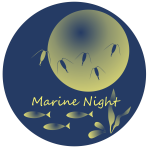The road map to Polar night studies started to develop before the International Polar Year more than 5 years ago. The ARCTOS network took part in many large IPY programmes, but none covered the darkest period of the Arctic winter. In 2006 we published a paper on Diel Vertical Migration during the Arctic Summer based on the data from an acoustic instrument (ADCP) mounted on the Observatory in Kongsfjorden. The year after, in 2007, the acoustic data from the observatory showed a clear diel vertical migration pattern of zooplankton during the Polar Night from November to March. After discussion and literature research it became clear that there was very little data, and a clear lack of knowledge and understanding, of marine life in the Arctic during the Polar Night. This triggered a large interest in Polar night biology of the Arctic Seas.
Then the self-appointed spiritual leader Jørgen Berge coupled up with gadget freak Geir Johnsen and the trip to the moon started. After they decided that the sun was not important, it was the circadian rhythms – but of course that was too boring: the moon was more interesting, and since then all was about the moon. The moon now rules the word, werewolves hunting in the dark, bioluminescence enables winter sex, and the fish with the largest balls swims in the deep, the bowheads have found the treasure at the rainbow’s end where the aurora sings during the polar night.
On this 7-day Polar night cruise we have been joined by scientist and students from Russia, Poland, Sweden, Scotland, England, Spain, Martinique, Denmark, USA, Germany and Norway. Participants represent several research projects, including MarineNight, CircA, MicroFun, Polarisation, and SpitsEco (see http://www.mare-incognitum.no/). The cruise also contributes to the University of Tromsø course BIO-8510 ARCTOS – Marine ecological research cruise to Svalbard (http://www.arctosresearch.net/) and AB-334 Underwater Robotics in the Arctic Polar Night given by UNIS (http://www.unis.no/).
Paul Renaud and Stig Falk-Petersen


